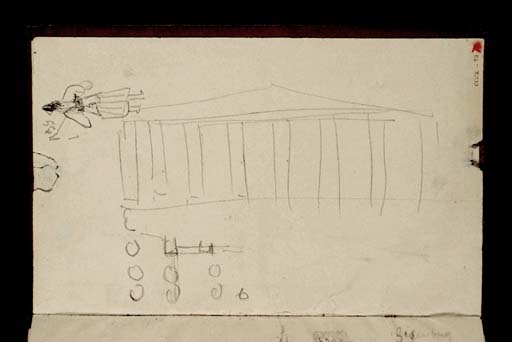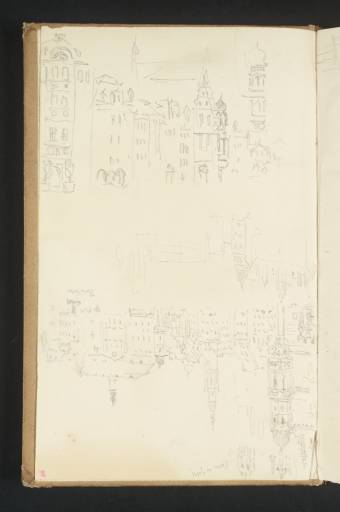Joseph Mallord William Turner Spitalgasse, Coburg, with the Lucchesehaus and Stadthaus, from the Weisser Schwan Hotel; the Market Place with St Moriz's Church and the Rathaus; the Stadthaus and Zeughaus 1840
Image 1 of 2
-
 Joseph Mallord William Turner, Spitalgasse, Coburg, with the Lucchesehaus and Stadthaus, from the Weisser Schwan Hotel; the Market Place with St Moriz's Church and the Rathaus; the Stadthaus and Zeughaus 1840
Joseph Mallord William Turner, Spitalgasse, Coburg, with the Lucchesehaus and Stadthaus, from the Weisser Schwan Hotel; the Market Place with St Moriz's Church and the Rathaus; the Stadthaus and Zeughaus 1840 -
 Joseph Mallord William Turner, Spitalgasse, Coburg, with the Lucchesehaus and Stadthaus, from the Weisser Schwan Hotel; the Market Place with St Moriz's Church and the Rathaus; the Stadthaus and Zeughaus 1840 (Enhanced image)Enhanced image
Joseph Mallord William Turner, Spitalgasse, Coburg, with the Lucchesehaus and Stadthaus, from the Weisser Schwan Hotel; the Market Place with St Moriz's Church and the Rathaus; the Stadthaus and Zeughaus 1840 (Enhanced image)Enhanced image
Joseph Mallord William Turner,
Spitalgasse, Coburg, with the Lucchesehaus and Stadthaus, from the Weisser Schwan Hotel; the Market Place with St Moriz's Church and the Rathaus; the Stadthaus and Zeughaus
1840
Joseph Mallord William Turner 1775–1851
Folio 1 Verso:
Spitalgasse, Coburg, with the Lucchesehaus and Stadthaus, from the Weisser Schwan Hotel; the Market Place with St Moriz’s Church and the Rathaus; the Stadthaus and Zeughaus 1840
D31278
Turner Bequest CCCX 1a
Turner Bequest CCCX 1a
Pencil on cream wove paper, 198 x 126 mm
Inscribed by Turner in pencil ‘Same as Gabel’ bottom centre, upside down, and ‘4 | 4 | 4’ on building and ‘Fountain’ towards bottom left, upside down
Inscribed by Turner in pencil ‘Same as Gabel’ bottom centre, upside down, and ‘4 | 4 | 4’ on building and ‘Fountain’ towards bottom left, upside down
Accepted by the nation as part of the Turner Bequest 1856
References
1909
A.J. Finberg, A Complete Inventory of the Drawings of the Turner Bequest, London 1909, vol.II, p.997, CCCX 1a, as ‘Do. [i.e. ditto: View of a town] (?Coburg.)’.
1995
Cecilia Powell, Turner in Germany, exhibition catalogue, Tate Gallery, London 1995, pp.71–2, 82 note 63, reproduced p.168 (detail), p.169 under nos.98 and 99, reproduced (another detail under latter), p.242, as ‘(1) Coburg: view from an upper floor of the Weisser Schwan of Spitalgasse from the Lucchesehaus to the market place, with detail of the Stadthaus | (2) Coburg: The Stadthaus, Zeughaus and St Moriz Church | (3) Coburg: the market place from Spitalgasse with architectural details | Inscr. Same as Gabel; 4; 4; 4; Fountain’.
The upper drawing shows ‘the view from an upper window of Turner’s hotel in Coburg, the Weisser Schwan in Spitalgasse which runs north from the market place’, with ‘the very ornate Lucchesehause with a curved pedimental roofline and giant figures supporting its entrance porch’ at the far left, and the ‘spire of St Moriz’s church which Turner could have seen only from an upstairs window in the hotel’.3 To the south-south-east towards the right is the profile of the elaborate late-Renaissance oriel turret at the corner of the Stadthaus on the near side of the market square, with a detail on a larger scale above to the right. As Powell has discussed, this view relates to a loose contemporary colour study on grey paper (Tate D32186; Turner Bequest CCCXVII 7), with a coach and various figures in the foreground.4
Below, the other way up, the main view is from the south end of Spitalgasse, with the same western corner of the Stadthaus in the foreground on the left and roofline details annotated above. Facing the south side of the square on the right, the prominent Baroque Rathaus features its own oriel corner to the left of its central portico, and three bands of ‘4’ windows noted rather than drawn to the right, below which the square’s fountain is both drawn and noted. The spire of St Moriz is seen more clearly to the south-east.
The slighter study running across the middle of the page below the second view is from the west side of the square, showing the gabled south front of the Stadthaus on the left with the Zeughaus beyond on an exaggerated scale, with only slight indications of the steeply pitched roofs of the less notable buildings on the east side to the right. Turner’s two market place views relate to another grey paper colour study (Tate D32187; Turner Bequest CCCXVII 8).5 A statue of Queen Victoria’s husband, Prince Albert of Saxe-Coburg-Gotha (1819–1861) now dominates the scene, as shown in Heinrich Justus Schneider’s painting of The Unveiling of the Prince Consort’s Statue in the Marketplace at Coburg, 16 August 1865 (1865–66; Royal Collection).
This last point indicates the immediate British interest in the town: Albert, born at Schloss Rosenau, a relatively modest family seat in the countryside about four miles to the north-east, had married his cousin Victoria in London on 10 February 1840, a few months before Turner’s tour. He subsequently exhibited a painting of Rosenau, as discussed under folio 22 recto (D31318), but also took time to explore picturesque Coburg itself, including Schloss Ehrenburg (the Saxe-Coburg-Gotha ducal palace) and the then rural surroundings around the Itz Valley, including the medieval Veste Coburg fortress, another Saxe-Coburg-Gotha seat high in parkland just to the north-east, and Schloss Ernsthöhe (later Hohenfels), newly completed for Duke Ernst von Württemberg, a cousin Albert’s,6 on the north-western outskirts.
As the sketchbook had already been well used in Venice and again since Passau, space was at a premium, and these subjects are scattered through it, sometimes sharing pages or alternating with earlier subjects; see folios 1 recto–4 recto, 5 recto–6 recto, 10 verso, 16 verso, 20 recto, 21 recto and verso, 22 verso–26 recto, 27 verso, 41 recto, 43 recto, the rectos of folios 59–64, and folio 67 verso and 69 verso (D31277–D31283, D31285–D31287, D31296, D31308, D31314, D31316–D31317, D31319–D31326, D31329, D31356, D31360, D31392, D31394, D31396, D31398, D31400, D31402, D31409, D31413). See also two more watercolour studies on grey paper (Tate D32188, D32190; Turner Bequest CCCXVII 9, 11), and a ‘colour beginning’-type study of Schloss Ernsthöhe and Veste Coburg (D36187; CCCLXIV 329). For Coburg within Turner’s 1840 itinerary, see the Introductions to this book and the overall tour.7
Matthew Imms
September 2018
How to cite
Matthew Imms, ‘Spitalgasse, Coburg, with the Lucchesehaus and Stadthaus, from the Weisser Schwan Hotel; the Market Place with St Moriz’s Church and the Rathaus; the Stadthaus and Zeughaus 1840 by Joseph Mallord William Turner’, catalogue entry, September 2018, in David Blayney Brown (ed.), J.M.W. Turner: Sketchbooks, Drawings and Watercolours, Tate Research Publication, December 2019, https://www

